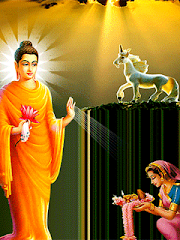.gif)
Siddhartha was born in Lumbini[11] and raised in the small kingdom or principality of Kapilvastu, both of which are in modern day Nepal. At the time, a multitude of small city-states existed in Ancient India, called Janapadas. Republics and chiefdoms with diffused political power and limited social stratification, were not uncommon amongst them, and were referred to as gana-sanghas.[12] The Buddha's community does not seem to have had a caste system. It was not a monarchy, and seems to have been structured either as an oligarchy, or as a form of republic.[13] The more egalitarian gana-sangha form of government, as a political alternative to the strongly hierarchical kingdoms, may have influenced the development of the Shramana type Jain and Buddhist sanghas, where monarchies tended toward Vedic Brahmanism


.gif)



